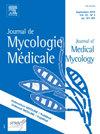肺之外:弥散性皮肤曲霉病病例报告,突出了危重患者侵袭性真菌感染的临床困境
IF 1.8
4区 医学
Q3 MYCOLOGY
引用次数: 0
摘要
随着机会性真菌病原体日益被认为是全球公共卫生威胁,侵袭性真菌感染(IFIs)的高风险人群已经扩大到传统免疫功能低下的个体,如恶性肿瘤、器官移植、糖尿病或获得性免疫缺陷综合征(艾滋病)患者,包括重症监护病房(icu)接受侵袭性支持和免疫调节治疗的危重患者。侵袭性曲霉病(IA)是该人群中最致命的机会性感染之一,其特点是发病隐匿、临床异质性和缺乏特异性体征,常常导致诊断延迟。播散性或突破性曲霉病具有极高的死亡率。我们报告一例因暴发性心肌炎入院的女性患者,她需要体外膜氧合(ECMO)、持续肾替代治疗(CRRT)和免疫调节。她的住院治疗因进行性肺部感染而变得复杂,呼吸道标本的新一代元基因组测序(mNGS)鉴定出白色念珠菌、曲霉菌和人型葡萄球菌,促使对抗菌治疗进行调整。随后,患者出现多个皮肤结节,组织活检和mNGS证实为侵袭性皮肤曲霉病。尽管使用isavuconazole和两性霉素B进行了积极的抗真菌治疗,她的病情仍迅速恶化,导致弥散性皮肤坏死、不可逆的感染性休克和多器官衰竭。本病例强调了识别非典型IFI表现的临床重要性。有肺外病变的危重患者应加强临床对弥散性真菌疾病的怀疑。及时的微生物学诊断和抗真菌耐药性监测对于有效的抗真菌治疗至关重要。本文章由计算机程序翻译,如有差异,请以英文原文为准。
Beyond the lungs: a case report of disseminated cutaneous aspergillosis highlighting clinical dilemmas in invasive fungal infections of critically ill patients
With opportunistic fungal pathogens increasingly recognized as a global public health threat, the population at high risk for invasive fungal infections (IFIs) has expanded beyond traditionally immunocompromised individuals—such as those with malignancies, organ transplantation, diabetes mellitus, or acquired immunodeficiency syndrome (AIDS)—to include critically ill patients in intensive care units (ICUs) receiving invasive support and immunomodulatory therapies. Invasive aspergillosis (IA) is one of the most lethal opportunistic infections in this population, characterized by insidious onset, clinical heterogeneity, and a lack of specific signs, often resulting in delayed diagnosis. Disseminated or breakthrough aspergillosis carries an exceedingly high mortality rate. We report the case of a female patient admitted to the ICU with fulminant myocarditis who required extracorporeal membrane oxygenation (ECMO), continuous renal replacement therapy (CRRT), and immunomodulation. Her hospitalization was complicated by a progressive pulmonary infection, and metagenomic next-generation sequencing (mNGS) of respiratory specimens identified Candida albicans, Aspergillus spp. and Staphylococcus hominis, prompting an adjustment in antimicrobial therapy. Subsequently, the patient developed multiple cutaneous nodules, which tissue biopsy and mNGS confirmed as invasive cutaneous aspergillosis. Despite aggressive antifungal treatment with isavuconazole and amphotericin B, her condition deteriorated rapidly, leading to disseminated cutaneous necrosis, irreversible septic shock and multiorgan failure. This case highlights the clinical importance of recognizing atypical IFI presentations. Heightened clinical suspicion for disseminated fungal disease is warranted in critically ill patients with extrapulmonary lesions. Prompt microbiological diagnosis and antifungal resistance surveillance are essential for effective antifungal therapy.
求助全文
通过发布文献求助,成功后即可免费获取论文全文。
去求助
来源期刊
CiteScore
5.10
自引率
2.80%
发文量
68
审稿时长
6-12 weeks
期刊介绍:
The Journal de Mycologie Medicale / Journal of Medical Mycology (JMM) publishes in English works dealing with human and animal mycology. The subjects treated are focused in particular on clinical, diagnostic, epidemiological, immunological, medical, pathological, preventive or therapeutic aspects of mycoses. Also covered are basic aspects linked primarily with morphology (electronic and photonic microscopy), physiology, biochemistry, cellular and molecular biology, immunochemistry, genetics, taxonomy or phylogeny of pathogenic or opportunistic fungi and actinomycetes in humans or animals. Studies of natural products showing inhibitory activity against pathogenic fungi cannot be considered without chemical characterization and identification of the compounds responsible for the inhibitory activity.
JMM publishes (guest) editorials, original articles, reviews (and minireviews), case reports, technical notes, letters to the editor and information. Only clinical cases with real originality (new species, new clinical present action, new geographical localization, etc.), and fully documented (identification methods, results, etc.), will be considered.
Under no circumstances does the journal guarantee publication before the editorial board makes its final decision.
The journal is indexed in the main international databases and is accessible worldwide through the ScienceDirect and ClinicalKey platforms.

 求助内容:
求助内容: 应助结果提醒方式:
应助结果提醒方式:


